Design Thinking for the Greater Good – Innovation in the Social Sector
Autor Jeanne Liedtka, Daisy Azer, Randy Salzmanen Limba Engleză Hardback – 25 sep 2017
Preț: 243.30 lei
Nou
Puncte Express: 365
Preț estimativ în valută:
46.57€ • 50.60$ • 39.14£
46.57€ • 50.60$ • 39.14£
Carte disponibilă
Livrare economică 31 martie-14 aprilie
Preluare comenzi: 021 569.72.76
Specificații
ISBN-13: 9780231179522
ISBN-10: 0231179529
Pagini: 352
Dimensiuni: 217 x 223 x 27 mm
Greutate: 0.95 kg
Editura: Columbia University Press
ISBN-10: 0231179529
Pagini: 352
Dimensiuni: 217 x 223 x 27 mm
Greutate: 0.95 kg
Editura: Columbia University Press
Notă biografică
Jeanne Liedtka is a professor at the Darden Graduate School of Business Administration at the University of Virginia. Her books include Solving Problems with Design Thinking (2013), Designing for Growth (2011), and The Designing for Growth Field Book (2013), all from Columbia University Press.
Randy Salzman is a journalist and former communications professor. His work has been published in over one hundred magazines, journals, and newspapers, from the Wall Street Journal and the New York Times to Mother Jones, Bicycling, and Style.
Daisy Azer is an an entrepreneur, principal at Waterbrand Consulting Inc., and adjunct lecturer of design thinking at the Darden Graduate School of Business. Her career spans roles in business development and training and development in the financial industry, education, and technology.
Randy Salzman is a journalist and former communications professor. His work has been published in over one hundred magazines, journals, and newspapers, from the Wall Street Journal and the New York Times to Mother Jones, Bicycling, and Style.
Daisy Azer is an an entrepreneur, principal at Waterbrand Consulting Inc., and adjunct lecturer of design thinking at the Darden Graduate School of Business. Her career spans roles in business development and training and development in the financial industry, education, and technology.
Cuprins
Acknowledgments
I. Why Design Thinking?
1. Catalyzing a Conversation for Change
2. How Do We Get There from Here? A Tale of Two Managers
II. The Stories
3. Igniting Creative Confidence at US Health and Human Services
4. Including New Voices at The Kingwood Trust
5. Scaling Design Thinking at Monash Medical Centre
6. Turning Debate into Dialogue at the US Food and Drug Administration
7. Fostering Community Conversations in Iveragh, Ireland
8. Connecting¿and Disconnecting¿the Pieces at United Cerebral Palsy
9. The Power of Local at the Community Transportation Association of America
10. Bridging Technology and the Human Experience at the Transportation Security Administration
11. Making Innovation Safe at MasAgro
12. Integrating Design and Strategy at Children¿s Health System of Texas
III. Moving into Action: Bringing Design Thinking to Your Organization
13. The Four-Question Methodology in Action: Laying the Foundation
14. The Four-Question Methodology in Action: Ideas to Experiments
15. Building Organizational Capabilities
Notes
Index
I. Why Design Thinking?
1. Catalyzing a Conversation for Change
2. How Do We Get There from Here? A Tale of Two Managers
II. The Stories
3. Igniting Creative Confidence at US Health and Human Services
4. Including New Voices at The Kingwood Trust
5. Scaling Design Thinking at Monash Medical Centre
6. Turning Debate into Dialogue at the US Food and Drug Administration
7. Fostering Community Conversations in Iveragh, Ireland
8. Connecting¿and Disconnecting¿the Pieces at United Cerebral Palsy
9. The Power of Local at the Community Transportation Association of America
10. Bridging Technology and the Human Experience at the Transportation Security Administration
11. Making Innovation Safe at MasAgro
12. Integrating Design and Strategy at Children¿s Health System of Texas
III. Moving into Action: Bringing Design Thinking to Your Organization
13. The Four-Question Methodology in Action: Laying the Foundation
14. The Four-Question Methodology in Action: Ideas to Experiments
15. Building Organizational Capabilities
Notes
Index



















